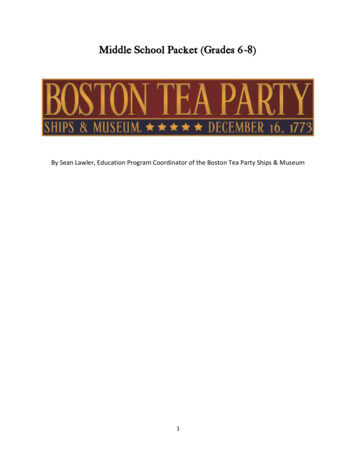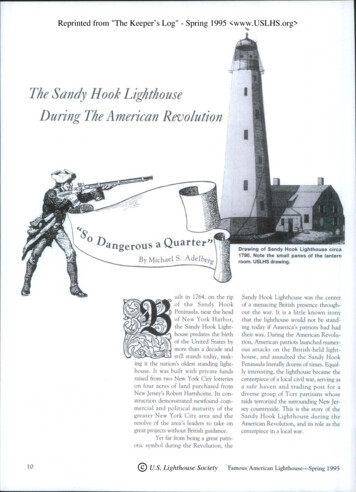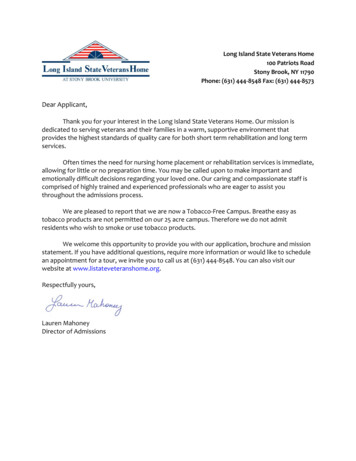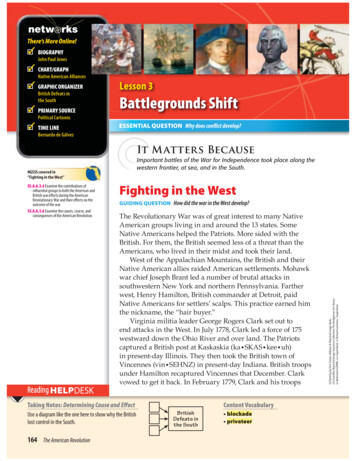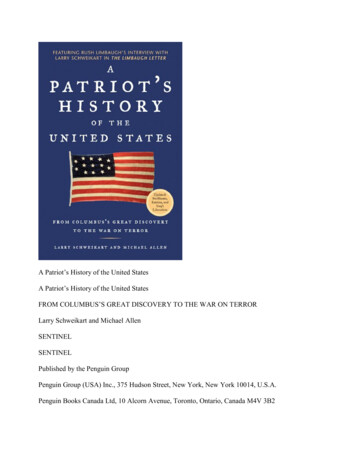
Transcription
A Patriot’s History of the United StatesA Patriot’s History of the United StatesFROM COLUMBUS’S GREAT DISCOVERY TO THE WAR ON TERRORLarry Schweikart and Michael AllenSENTINELSENTINELPublished by the Penguin GroupPenguin Group (USA) Inc., 375 Hudson Street, New York, New York 10014, U.S.A.Penguin Books Canada Ltd, 10 Alcorn Avenue, Toronto, Ontario, Canada M4V 3B2
Penguin Books Ltd, 80 Strand, London WC2R 0RL, EnglandPenguin Books Australia Ltd, 250 Camberwell Road, Camberwell, Victoria 3124, AustraliaPenguin Books India (P) Ltd, 11 Community Centre, Panchsheel Park, New Delhi–110 017, IndiaPenguin Group (NZ), Cnr Airborne and Rosedale Roads, Albany, Auckland 1310, New ZealandPenguin Books (South Africa) (Pty) Ltd, 24 Sturdee Avenue, Rosebank, Johannesburg 2196, SouthAfricaPenguin Books Ltd, Registered Offices: 80 Strand, London WC2R 0RL, EnglandFirst published in 2004 by Sentinel, a member of Penguin Group (USA) Inc.Copyright Larry Schweikart and Michael Allen, 2004All rights reservedCIP DATA AVAILABLE.ISBN: 1-4295-2229-1Without limiting the rights under copyright reserved above, no part of this publication may bereproduced, stored in or introduced into a retrieval system, or transmitted, in any form or by anymeans (electronic, mechanical, photocopying, recording or otherwise), without the prior writtenpermission of both the copyright owner and the above publisher of this book.The scanning, uploading, and distribution of this book via the Internet or via any other meanswithout the permission of the publisher is illegal and punishable by law. Please purchase onlyauthorized electronic editions and do not participate in or encourage electronic piracy ofcopyrighted materials. Your support of the author’s rights is appreciated.To Dee and Adam—Larry SchweikartFor my mom—Michael AllenACKNOWLEDGMENTSLarry Schweikart would like to thank Jesse McIntyre and Aaron Sorrentino for their contribution tocharts and graphs; and Julia Cupples, Brian Rogan, Andrew Gough, and Danielle Elam for
research. Cynthia King performed heroic typing work on crash schedules. The University ofDayton, particularly Dean Paul Morman, supported this work through a number of grants.Michael Allen would like to thank Bill Richardson, Director of Interdisciplinary Arts and Sciencesat the University of Washington, Tacoma, for his friendship and collegial support for over a decade.We would both like to thank Mark Smith, David Beito, Brad Birzer, Robert Loewenberg, JeffHanichen, David Horowitz, Jonathan Bean, Constantine Gutzman, Burton Folsom Jr., Julius Amin,and Michael Etchison for comments on the manuscript. Ed Knappman and the staff at NewEngland Publishing Associates believed in this book from the beginning and have our undyinggratitude. Our special thanks to Bernadette Malone, whose efforts made this possible; to MeganCasey for her sharp eye; and to David Freddoso for his ruthless, but much needed, pen.CONTENTSACKNOWLEDGMENTSINTRODUCTIONCHAPTER ONE:The City on the Hill, 1492–1707CHAPTER TWO:Colonial Adolescence, 1707–63CHAPTER THREE:Colonies No More, 1763–83CHAPTER FOUR:A Nation of Law, 1776–89CHAPTER FIVE:Small Republic, Big Shoulders, 1789–1815CHAPTER SIX:The First Era of Big Central Government, 1815–36CHAPTER SEVEN:Red Foxes and Bear Flags, 1836–48
CHAPTER EIGHT:The House Dividing, 1848–60CHAPTER NINE:The Crisis of the Union, 1860–65CHAPTER TEN:Ideals and Realities of Reconstruction, 1865–76CHAPTER ELEVEN:Lighting Out for the Territories, 1861–90CHAPTER TWELVE:Sinews of Democracy, 1876–96CHAPTER THIRTEEN:“Building Best, Building Greatly,” 1896–1912CHAPTER FOURTEEN:War, Wilson, and Internationalism, 1912–20CHAPTER FIFTEEN:The Roaring Twenties and the Great Crash, 1920–32CHAPTER SIXTEEN:Enlarging the Public Sector, 1932–40 The New Deal: Immediate Goals, Unintended ResultsCHAPTER SEVENTEEN:Democracy’s Finest Hour, 1941–45CHAPTER EIGHTEEN:America’s “Happy Days,” 1946–59CHAPTER NINETEEN:
The Age of Upheaval, 1960–74CHAPTER TWENTY:Retreat and Resurrection, 1974–88CHAPTER TWENTY-ONE:The Moral Crossroads, 1989–2000CHAPTER TWENTY-TWO:America, World Leader, 2000 and BeyondCONCLUSIONNOTESSELECTED READINGINDEXINTRODUCTIONIs America’s past a tale of racism, sexism, and bigotry? Is it the story of the conquest and rape of acontinent? Is U.S. history the story of white slave owners who perverted the electoral process fortheir own interests? Did America start with Columbus’s killing all the Indians, leap to Jim Crowlaws and Rockefeller crushing the workers, then finally save itself with Franklin Roosevelt’s NewDeal? The answers, of course, are no, no, no, and NO.One might never know this, however, by looking at almost any mainstream U.S. history textbook.Having taught American history in one form or another for close to sixty years between us, we areaware that, unfortunately, many students are berated with tales of the Founders as self-interestedpoliticians and slaveholders, of the icons of American industry as robber-baron oppressors, and ofevery American foreign policy initiative as imperialistic and insensitive. At least Howard Zinn’s APeople’s History of the United States honestly represents its Marxist biases in the title!What is most amazing and refreshing is that the past usually speaks for itself. The evidence is therefor telling the great story of the American past honestly—with flaws, absolutely; withshortcomings, most definitely. But we think that an honest evaluation of the history of the UnitedStates must begin and end with the recognition that, compared to any other nation, America’s pastis a bright and shining light. America was, and is, the city on the hill, the fountain of hope, thebeacon of liberty. We utterly reject “My country right or wrong”—what scholar wouldn’t? But inthe last thirty years, academics have taken an equally destructive approach: “My country, alwayswrong!” We reject that too.
Instead, we remain convinced that if the story of America’s past is told fairly, the result cannot beanything but a deepened patriotism, a sense of awe at the obstacles overcome, the passion invested,the blood and tears spilled, and the nation that was built. An honest review of America’s past wouldnote, among other observations, that the same Founders who owned slaves instituted numerousways—political and intellectual—to ensure that slavery could not survive; that the concern over notjust property rights, but all rights, so infused American life that laws often followed the practices ofthe common folk, rather than dictated to them; that even when the United States used her militarypower for dubious reasons, the ultimate result was to liberate people and bring a higher standard ofliving than before; that time and again America’s leaders have willingly shared power with thosewho had none, whether they were citizens of territories, former slaves, or disenfranchised women.And we could go on.The reason so many academics miss the real history of America is that they assume that ideas don’tmatter and that there is no such thing as virtue. They could not be more wrong. When John D.Rockefeller said, “The common man must have kerosene and he must have it cheap,” Rockefellerwas already a wealthy man with no more to gain. When Grover Cleveland vetoed an insignificantseed corn bill, he knew it would hurt him politically, and that he would only win condemnationfrom the press and the people—but the Constitution did not permit it, and he refused.Consider the scene more than two hundred years ago when President John Adams—just voted outof office by the hated Republicans of Thomas Jefferson—mounted a carriage and left Washingtoneven before the inauguration. There was no armed struggle. Not a musket ball was fired, nor apolitical opponent hanged. No Federalists marched with guns or knives in the streets. There was noguillotine. And just four years before that, in 1796, Adams had taken part in an equally momentousevent when he won a razor-thin close election over Jefferson and, because of Senate rules, had tocount his own contested ballots. When he came to the contested Georgia ballot, the greatMassachusetts revolutionary, the “Duke of Braintree,” stopped counting. He sat down for a momentto allow Jefferson or his associates to make a challenge, and when he did not, Adams finished thetally, becoming president. Jefferson told confidants that he thought the ballots were indeed indispute, but he would not wreck the country over a few pieces of paper. As Adams took the oath ofoffice, he thought he heard Washington say, “I am fairly out and you are fairly in! See which of uswill be the happiest!”1 So much for protecting his own interests! Washington stepped down freelyand enthusiastically, not at bayonet point. He walked away from power, as nearly each and everyAmerican president has done since.These giants knew that their actions of character mattered far more to the nation they were creatingthan mere temporary political positions. The ideas they fought for together in 1776 and debated in1787 were paramount. And that is what American history is truly about—ideas. Ideas such as “Allmen are created equal”; the United States is the “last, best hope” of earth; and America “is great,because it is good.”Honor counted to founding patriots like Adams, Jefferson, Washington, and then later, Lincoln andTeddy Roosevelt. Character counted. Property was also important; no denying that, because withproperty came liberty. But virtue came first. Even J. P. Morgan, the epitome of the so-called robber
baron, insisted that “the first thing is character before money or anything else. Money cannot buyit.”It is not surprising, then, that so many left-wing historians miss the boat (and miss it, and miss it,and miss it to the point where they need a ferry schedule). They fail to understand what everycolonial settler and every western pioneer understood: character was tied to liberty, and liberty toproperty. All three were needed for success, but character was the prerequisite because it put thelaw behind property agreements, and it set responsibility right next to liberty. And the surest way toensure the presence of good character was to keep God at the center of one’s life, community, andultimately, nation. “Separation of church and state” meant freedom to worship, not freedom fromworship. It went back to that link between liberty and responsibility, and no one could be takenseriously who was not responsible to God. “Where the Spirit of the Lord is, there is liberty.” Theybelieved those words.As colonies became independent and as the nation grew, these ideas permeated the fabric of thefounding documents. Despite pits of corruption that have pockmarked federal and state politics—some of them quite deep—and despite abuses of civil rights that were shocking, to say the least, theconcept was deeply imbedded that only a virtuous nation could achieve the lofty goals set by theFounders. Over the long haul, the Republic required virtuous leaders to prosper.Yet virtue and character alone were not enough. It took competence, skill, and talent to build anation. That’s where property came in: with secure property rights, people from all over the globeflocked to America’s shores. With secure property rights, anyone could become successful, from animmigrant Jew like Lionel Cohen and his famous Lionel toy trains to an Austrian bodybuilderturned-millionaire actor and governor like Arnold Schwarzenegger. Carnegie arrived penniless;Ford’s company went broke; and Lee Iacocca had to eat crow on national TV for his company’smistakes. Secure property rights not only made it possible for them all to succeed but, moreimportant, established a climate of competition that rewarded skill, talent, and risk taking.Political skill was essential too. From 1850 to 1860 the United States was nearly rent in half byinept leaders, whereas an integrity vacuum nearly destroyed American foreign policy and shatteredthe economy in the decades of the 1960s and early 1970s. Moral, even pious, men have taken thenation to the brink of collapse because they lacked skill, and some of the most skilled politicians inthe world—Henry Clay, Richard Nixon, Bill Clinton—left legacies of frustration and corruptionbecause their abilities were never wedded to character.Throughout much of the twentieth century, there was a subtle and, at times, obvious campaign toseparate virtue from talent, to divide character from success. The latest in this line of attack is theemphasis on diversity—that somehow merely having different skin shades or national originsmakes America special. But it was not the color of the skin of people who came here that madethem special, it was the content of their character. America remains a beacon of liberty, not merelybecause its institutions have generally remained strong, its citizens free, and its attitudes tolerant,but because it, among most of the developed world, still cries out as a nation, “Character counts.”Personal liberties in America are genuine because of the character of honest judges and attorneyswho, for the most part, still make up the judiciary, and because of the personal integrity of largenumbers of local, state, and national lawmakers.
No society is free from corruption. The difference is that in America, corruption is viewed as theexception, not the rule. And when light is shown on it, corruption is viciously attacked. Freedomstill attracts people to the fountain of hope that is America, but freedom alone is not enough.Without responsibility and virtue, freedom becomes a soggy anarchy, an incomplete licentiousness.This is what has made Americans different: their fusion of freedom and integrity endowsAmericans with their sense of right, often when no other nation in the world shares their perception.Yet that is as telling about other nations as it is our own; perhaps it is that as Americans, we aloneremain committed to both the individual and the greater good, to personal freedoms and to publicvirtue, to human achievement and respect for the Almighty. Slavery was abolished because of thedual commitment to liberty and virtue—neither capable of standing without the other. Somecrusades in the name of integrity have proven disastrous, including Prohibition. The most recentserious threats to both liberty and public virtue (abuse of the latter damages both) have come in theform of the modern environmental and consumer safety movements. Attempts to sue gun makers,paint manufacturers, tobacco companies, and even Microsoft “for the public good” have madedistressingly steady advances, encroaching on Americans’ freedoms to eat fast foods, smoke, ormodify their automobiles, not to mention start businesses or invest in existing firms without fear ofretribution.The Founders—each and every one of them—would have been horrified at such intrusions onliberty, regardless of the virtue of the cause, not because they were elite white men, but becausesuch actions in the name of the public good were simply wrong. It all goes back to character: thebest way to ensure virtuous institutions (whether government, business, schools, or churches) wasto populate them with people of virtue. Europe forgot this in the nineteenth century, or by WorldWar I at the latest. Despite rigorous and punitive face-saving traditions in the Middle East or Asia,these twin principles of liberty and virtue have never been adopted. Only in America, where onewas permitted to do almost anything, but expected to do the best thing, did these principlesgerminate.To a great extent, that is why, on March 4, 1801, John Adams would have thought of nothing otherthan to turn the White House over to his hated foe, without fanfare, self-pity, or complaint, andreturn to his everyday life away from politics. That is why, on the few occasions where very thinelectoral margins produced no clear winner in the presidential race (such as 1824, 1876, 1888,1960, and 2000), the losers (after some legal maneuvering, recounting of votes, and occasionalwhining) nevertheless stepped aside and congratulated the winner of a different party. Adams mayhave set a precedent, but in truth he would do nothing else. After all, he was a man of character.A Patriot’s History of the United StatesCHAPTER ONEThe City on the Hill, 1492–1707The Age of European Discovery
God, glory, and gold—not necessarily in that order—took post-Renaissance Europeans to parts ofthe globe they had never before seen. The opportunity to gain materially while bringing the Gospelto non-Christians offered powerful incentives to explorers from Portugal, Spain, England, andFrance to embark on dangerous voyages of discovery in the 1400s. Certainly they were not the firstto sail to the Western Hemisphere: Norse sailors reached the coasts of Iceland in 874 andGreenland a century later, and legends recorded Leif Erickson’s establishment of a colony inVinland, somewhere on the northern Canadian coast.1 Whatever the fate of Vinland, its historicalimpact was minimal, and significant voyages of discovery did not occur for more than five hundredyears, when trade with the Orient beckoned.Marco Polo and other travelers to Cathay (China) had brought exaggerated tales of wealth in theEast and returned with unusual spices, dyes, rugs, silks, and other goods. But this was a difficult,long journey. Land routes crossed dangerous territories, including imposing mountains and vastdeserts of modern-day Afghanistan, northern India, Iran, and Iraq, and required expensive and wellprotected caravans to reach Europe from Asia. Merchants encountered bandits who threatenedtransportation lanes, kings and potentates who demanded tribute, and bloodthirsty killers whopillaged for pleasure. Trade routes from Bombay and Goa reached Europe via Persia or Arabia,crossing the Ottoman Empire with its internal taxes. Cargo had to be unloaded at seaports, thenreloaded at Alexandria or Antioch for water transport across the Mediterranean, or continued onland before crossing the Dardanelles Strait into modern-day Bulgaria to the Danube River.European demand for such goods seemed endless, enticing merchants and their investors to engagein a relentless search for lower costs brought by safer and cheaper routes. Gradually, Europeansconcluded that more direct water routes to the Far East must exist.The search for Cathay’s treasure coincided with three factors that made long ocean voyagespossible. First, sailing and shipbuilding technology had advanced rapidly after the ninth century,thanks in part to the Arabs’ development of the astrolabe, a device with a pivoted limb thatestablished the sun’s altitude above the horizon. By the late tenth century, astrolabe technology hadmade its way to Spain.2 Farther north, Vikings pioneered new methods of hull construction, amongthem the use of overlapping planks for internal support that enabled vessels to withstand violentocean storms. Sailors of the Hanseatic League states on the Baltic coast experimented with largership designs that incorporated sternpost rudders for better control. Yet improved ships alone werenot enough: explorers needed the accurate maps generated by Italian seamen and sparked by thenew inquisitive impulse of the Renaissance. Thus a wide range of technologies coalesced toencourage long-range voyages of discovery.Political changes, a second factor giving birth to the age of discovery, resulted from the efforts ofseveral ambitious European monarchs to consolidate their possessions into larger, cohesivedynastic states. This unification of lands, which increased the taxable base within the kingdoms,greatly increased the funding available to expeditions and provided better military protection (in theform of warships) at no cost to investors. By the time a combined Venetian-Spanish fleet defeated amuch larger Ottoman force at Lepanto in 1571, the vessels of Christian nations could essentiallysail with impunity anywhere in the Mediterranean. Then, in control of the Mediterranean,Europeans could consider voyages of much longer duration (and cost) than they ever had in thepast. A new generation of explorers found that monarchs could support even more expensiveundertakings that integrated the monarch’s interests with the merchants’.3
Third, the Protestant Reformation of 1517 fostered a fierce and bloody competition for power andterritory between Catholic and Protestant nations that reinforced national concerns. Englandcompeted for land with Spain, not merely for economic and political reasons, but because theEnglish feared the possibility that Spain might catholicize numbers of non-Christians in new lands,whereas Catholics trembled at the thought of subjecting natives to Protestant heresies. Therefore,even when economic or political gains for discovery and colonization may have been marginal,monarchs had strong religious incentives to open their royal treasuries to support such missions.Time Line1492–1504:Columbus’s four voyages1519–21:Cortés conquers Mexico1585–87:Roanoke Island (Carolinas) colony fails1607:Jamestown, Virginia, founded1619:First Africans arrive in Virginia1619:Virginia House of Burgesses formed1620:Pilgrims found Plymouth, Massachusetts1630:Puritan migration to Massachusetts1634:Calverts found Maryland
1635–36:Pequot Indian War (Massachusetts)1638:Anne Hutchinson convicted of heresy1639:Fundamental Orders of Connecticut1642–48:English Civil War1650:First Navigation Act (mercantilism)1664:English conquer New Netherlands (New York)1675–76:King Philip’s (Metacomet’s) War (Massachusetts)1676:Bacon’s Rebellion (Virginia)1682:Pennsylvania settled1688–89:English Glorious Revolution and Bill of Rights1691:Massachusetts becomes royal colony1692:
Salem witch huntsPortugal and Spain: The ExplorersIronically, one of the smallest of the new monarchical states, Portugal, became the first to subsidizeextensive exploration in the fifteenth century. The most famous of the Portuguese explorers, PrinceHenry, dubbed the Navigator, was the brother of King Edward of Portugal. Henry (1394–1460) hadearned a reputation as a tenacious fighter in North Africa against the Moors, and he hoped to rollback the Muslim invaders and reclaim from them trade routes and territory.A true Renaissance man, Henry immersed himself in mapmaking and exploration from a coastalcenter he established at Sagres, on the southern point of Portugal. There he trained navigators andmapmakers, dispatched ships to probe the African coast, and evaluated the reports of sailors whoreturned from the Azores.4 Portuguese captains made contact with Arabs and Africans in coastalareas and established trading centers, from which they brought ivory and gold to Portugal, thentransported slaves to a variety of Mediterranean estates. This early slave trade was conductedthrough Arab middlemen or African traders who carried out slaving expeditions in the interior andexchanged captive men, women, and children for fish, wine, or salt on the coast.Henry saw these relatively small trading outposts as only the first step in developing reliable waterroutes to the East. Daring sailors trained at Henry’s school soon pushed farther southward, finallyrounding the Cape of Storms in 1486, when Bartholomeu Dias was blown off course by fantasticwinds. King John II eventually changed the name of the cape to the Cape of Good Hope, reflectingthe promise of a new route to India offered by Dias’s discovery. That promise became reality in1498, after Vasco de Gama sailed to Calicut, India. An abrupt decline in Portuguese fortunes led toher eclipse by the larger Spain, reducing the resources available for investment in exploration andlimiting Portuguese voyages to the Indian Ocean to an occasional “boatload of convicts.”5Moreover, the prize for which Portuguese explorers had risked so much now seemed small incomparison to that discovered by their rivals the Spanish under the bold seamanship of ChristopherColumbus, a man the king of Portugal had once refused to fund.Columbus departed from Spain in August 1492, laying in a course due west and ultimately in adirect line to Japan, although he never mentioned Cathay prior to 1493.6 A native of Genoa,Columbus embodied the best of the new generation of navigators: resilient, courageous, andconfident. To be sure, Columbus wanted glory, and a motivation born of desperation fueled hisvision. At the same time, Columbus was “earnestly desirous of taking Christianity to heathenlands.”7 He did not, as is popularly believed, originate the idea that the earth is round. As early as1480, for example, he read works proclaiming the sphericity of the planet. But knowingintellectually that the earth is round and demonstrating it physically are two different things.Columbus’s fleet consisted of only three vessels, the Niña, the Pinta, and the Santa María, and acrew of ninety men. Leaving port in August 1492, the expedition eventually passed the point wherethe sailors expected to find Japan, generating no small degree of anxiety, whereupon Columbusused every managerial skill he possessed to maintain discipline and encourage hope. The voyagehad stretched to ten weeks when the crew bordered on mutiny, and only the captain’s reassurance
and exhortations persuaded the sailors to continue a few more days. Finally, on October 11, 1492,they started to see signs of land: pieces of wood loaded with barnacles, green bulrushes, and othervegetation.8 A lookout spotted land, and on October 12, 1492, the courageous band waded ashoreon Watling Island in the Bahamas, where his men begged his pardon for doubting him.9Columbus continued to Cuba, which he called Hispaniola. At the time he thought he had reachedthe Far East, and referred to the dark-skinned people he found in Hispaniola as Indians. He foundthese Indians “very well formed, with handsome bodies and good faces,” and hoped to convertthem “to our Holy Faith by love rather than by force” by giving them red caps and glass beads “andmany other things of small value.”10 Dispatching emissaries into the interior to contact the GreatKhan, Columbus’s scouts returned with no reports of the spices, jewels, silks, or other evidence ofCathay; nor did the khan send his regards. Nevertheless, Columbus returned to Spain confident hehad found an ocean passage to the Orient.11Reality gradually forced Columbus to a new conclusion: he had not reached India or China, andafter a second voyage in 1493—still convinced he was in the Pacific Ocean—Columbus admittedhe had stumbled on a new land mass, perhaps even a new continent of astounding natural resourcesand wealth. In February 1493, he wrote his Spanish patrons that Hispaniola and other islands like itwere “fertile to a limitless degree,” possessing mountains covered by “trees of a thousand kinds andtall, so that they seem to touch the sky.”12 He confidently promised gold, cotton, spices—as muchas Their Highnesses should command—in return for only minimal continued support. Meanwhile,he continued to probe the Mundus Novus south and west. After returning to Spain yet again,Columbus made two more voyages to the New World in 1498 and 1502.Whether Columbus had found parts of the Far East or an entirely new land was irrelevant to mostEuropeans at the time. Political distractions abounded in Europe. Spain had barely evicted theMuslims after the long Reconquista, and England’s Wars of the Roses had scarcely ended. News ofColumbus’s discoveries excited only a few merchants, explorers, and dreamers. Still, the prospectof finding a waterway to Asia infatuated sailors; and in 1501 a Florentine passenger on aPortuguese voyage, Amerigo Vespucci, wrote letters to his friends in which he described the NewWorld. His self-promoting dispatches circulated sooner than Columbus’s own written accounts, andas a result the term “America” soon was attached by geographers to the continents in the WesternHemisphere that should by right have been named Columbia. But if Columbus did not receive thehonor of having the New World named for him, and if he acquired only temporary wealth and famein Spain (receiving from the Crown the title Admiral of the Ocean Sea), his place in history wasnever in doubt. Historian Samuel Eliot Morison, a worthy seaman in his own right who reenactedthe Columbian voyages in 1939 and 1940, described Columbus as “the sign and symbol [of the]new age of hope, glory and accomplishment.”13Once Columbus blazed the trail, other Spanish explorers had less trouble obtaining financialbacking for expeditions. Vasco Núñez de Balboa (1513) crossed the Isthmus of Panama to thePacific Ocean (as he named it). Ferdinand Magellan (1519–22) circumnavigated the globe, lendinghis name to the Strait of Magellan. Other expeditions explored the interior of the newly discoveredlands. Juan Ponce de León, traversing an area along Florida’s coast, attempted unsuccessfully toplant a colony there. Pánfilo de Narváez’s subsequent expedition to conquer Tampa Bay proved
even more disastrous. Narváez himself drowned, and natives killed members of his expedition untilonly four of them reached a Spanish settlement in Mexico.Spaniards traversed modern-day Mexico, probing interior areas under Hernando Cortés, who in1518 led a force of 1,000 soldiers to Tenochtitlán, the site of present-day Mexico City. Cortésencountered powerful Indians called Aztecs, led by their emperor Montezuma. The Aztecs hadestablished a brutal regime that oppressed other natives of the region, capturing large numbers ofthem for ritual sacrifices in which Aztec priests cut out the beating hearts of living victims. Suchbarbarity enabled the Spanish to easily enlist other tribes, especially the Tlaxcalans, in their effortsto defeat the Aztecs.Tenochtitlán sat on an island in the middle of a lake, connected to the outlying areas by three hugecauseways. It was a monstrously large city (for the time) of at least 200,000, rigidly divided intonobles and commoner groups.14 Aztec culture created impressive pyramid-s
1787 were paramount. And that is what American history is truly about—ideas. Ideas such as "All men are created equal"; the United States is the "last, best hope" of earth; and America "is great, because it is good." Honor counted to founding patriots like Adams, Jefferson, Washington, and then later, Lincoln and Teddy Roosevelt.



